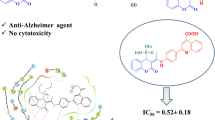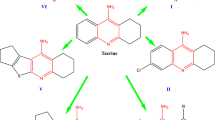Abstract
Acetylcholinesterase (AChE) inhibitors are of widespread interest to the pharmaceutical communities. Herein, 34 organoselenium compounds were synthesized in good yields and evaluated for their AChE inhibition and glutathione peroxidase (GPX) like activities. The highest AChE inhibition efficiency was observed for the tetrazole-based selenocyanate 12 (64%), selenonaphthoquinone-based urea 39 (63.1%), tetrazole-based diselenide 25 (59.4%), selenocyanate-based urea 18 (58.4%) and selenobenzoquinone-based urea 36 (57.9%). On the other hand, the GPX highest activity was recorded for the pseudopeptide-based diselenides 21 (48.5 μM/min). Fair-moderate activities were observed for the pseudopeptide-based diselenides 22 (24.4 μM/min) and 24 (18.3 μM/min). Docking studies for 8, 12, 18, 25, and 39 compounds in AChE active site showed their similar orientation to Donepezil at the catalytic site (CAS) and the peripheral anionic site (PAS), a result that supports their inhibitory effect. This study presents a new set of synthetic organoselenium compounds with a significant inhibitory effect against AChE.







Similar content being viewed by others
References
Perry G, Raina AK, Nunomura A, Wataya T, Sayre LM, Smith MA. How important is oxidative damage? Lessons from alzheimer’s disease. Free Radic Biol Med. 2000;28:831–4.
Johannesson T, Kristinsson J, Snaedal J. Neurodegenerative diseases, antioxidative enzymes and copper. A review of experimental research. Laeknabladid. 2003;89:659–71.
Lizard G, Rouaud O, Demarquoy J, Cherkaoui-Malki M, Iuliano L. Potential roles of peroxisomes in alzheimer’s disease and in dementia of the alzheimer’s type. J Alzheimers Dis. 2020;29:241–54. https://doi.org/10.3233/JAD-2011-111163.
Vanzulli I, Papanikolaou M, De La R, Irene C, Pieropan F, Rivera AD, Gomez-Nicola D, et al. Disruption of oligodendrocyte progenitor cells is an early sign of pathology in the triple transgenic mouse model of alzheimer’s disease. Neurobiol Aging. 2020;1:130–9. https://doi.org/10.1016/j.neurobiolaging.2020.05.016.
Pinton S, Brüning CA, Sartori Oliveira CE, Prigol M, Nogueira CW. Therapeutic effect of organoselenium dietary supplementation in a sporadic dementia of alzheimer’s type model in rats. J Nutr Biochem.2013;24:311–7. https://doi.org/10.1016/j.jnutbio.2012.06.012.
Fabiani C, Antollini SS. Alzheimer’s disease as a membrane disorder: spatial cross-talk among beta-amyloid peptides, nicotinic acetylcholine receptors and lipid rafts. Front Cell Neurosci. 2019;13:309. https://doi.org/10.3389/fncel.2019.00309.
Sabri O, Meyer PM, Gräf S, Hesse S, Wilke S, Becker GA, et al. Cognitive correlates of α4β2 nicotinic acetylcholine receptors in mild alzheimer’s dementia. Brain. 2018;141:1840–54. https://doi.org/10.1093/brain/awy099.
Girek M, Szymański P. Tacrine hybrids as multi-target-directed ligands in alzheimer’s disease: Influence of chemical structures on biological activities. Chem Pap. 2019;73:269–89. https://doi.org/10.1007/s11696-018-0590-8.
Piemontese L, Tomás D, Hiremathad A, Capriati V, Candeias E, Cardoso SM, et al. Donepezil structure-based hybrids as potential multifunctional anti-alzheimer’s drug candidates. J Enzym Inhibition Medicinal Chem. 2018;33:1212–24. https://doi.org/10.1080/14756366.2018.1491564.
Birks JS, Harvey RJ. Donepezil for dementia due to alzheimer’s disease. Cochrane Database of systematic reviews. 2018. https://doi.org/10.1002/14651858.CD001190.pub3.
Saleem U, Sabir S, Niazi SG, Naeem M, Ahmad B. Role of oxidative stress and antioxidant defense biomarkers in neurodegenerative diseases. Critical Reviews™ in Eukaryotic Gene Expression. 2020;30. https://doi.org/10.1615/CritRevEukaryotGeneExpr.2020029202.
Butterfield DA, Halliwell B. Oxidative stress, dysfunctional glucose metabolism and alzheimer disease. Nat Rev Neurosci. 2019;20:148–60. https://doi.org/10.1038/s41583-019-0132-6.
Narayanankutty A, Job JT, Narayanankutty V. Glutathione, an antioxidant tripeptide: Dual roles in carcinogenesis and chemoprevention. Curr Protein Pept Sci. 2019;20:907–17. https://doi.org/10.2174/1389203720666190206130003.
Xu J, Gong Y, Sun Y, Cai J, Liu Q, Bao J, et al. Impact of selenium deficiency on inflammation, oxidative stress, and phagocytosis in mouse macrophages. Biol Trace Elem Res. 2020;194:237–43. https://doi.org/10.1007/s12011-019-01775-7.
Schomburg L. The other view: The trace element selenium as a micronutrient in thyroid disease, diabetes, and beyond. Hormones. 2020:1–10. https://doi.org/10.1007/s42000-019-00150-4.
Sanmartin C, Ruberte AC, Ibanez E, Moreno E, Espuelas S, Plano D. Selenium entities: Promising scaffolds for the treatment of cancer and leishmania. Curr Org Synth. 2017;14:1075–81. https://doi.org/10.2174/1570179414666170517153921.
Bodnar M, Szczyglowska M, Konieczka P, Namiesnik J. Methods of selenium supplementation: Bioavailability and determination of selenium compounds. Crit Rev Food Sci Nutr.2016;56:36–55. https://doi.org/10.1080/10408398.2012.709550.
Cardoso BR, Roberts BR, Bush AI, Hare DJ. Selenium, selenoproteins and neurodegenerative diseases. Metallomics. 2015;7:1213–28. https://doi.org/10.1039/c5mt00075k.
Wirth T. Small organoselenium compounds: More than just glutathione peroxidase mimics. Angew Chem Int Ed. 2015;54:10074–6. https://doi.org/10.1002/anie.201505056.
Ibrahim M, Muhammad N, Naeem M, Deobald AM, Kamdem JP, Rocha JB. In vitro evaluation of glutathione peroxidase (GPx)-like activity and antioxidant properties of an organoselenium compound. Toxicol Vitr.2015;29:947–52. https://doi.org/10.1016/j.tiv.2015.03.017.
Luo Z, Liang L, Sheng J, Pang Y, Li J, Huang L, et al. Synthesis and biological evaluation of a new series of ebselen derivatives as glutathione peroxidase (GPx) mimics and cholinesterase inhibitors against alzheimer’s disease. Bioorg Med Chem. 2014;22:1355–61. https://doi.org/10.1016/j.bmc.2013.12.066.
Parnham MJ, Sies H. The early research and development of ebselen. Biochem Pharmacol.2013;86:1248–53. https://doi.org/10.1016/j.bcp.2013.08.028.
Galant LS, Rafique J, Braga AL, Braga FC, Saba S, Radi R, et al. The thiol-modifier effects of organoselenium compounds and their cytoprotective actions in neuronal cells. Neurochem. Res. 2020;1-11. https://doi.org/10.1007/s11064-020-03026-x.
Chen Z, Lai H, Hou L, Chen T. Rational design and action mechanisms of chemically innovative organoselenium in cancer therapy. Chem Commun. 2020;56:179–96. https://doi.org/10.1039/C9CC07683B.
He X, Zhong M, Li S, Li Y, Li Z, Gao Y, et al. Synthesis and biological evaluation of organoselenium (NSAIDs-SeCN and SeCF3) derivatives as potential anticancer agents. Eur J Med Chem.2020;15:112864. https://doi.org/10.1016/j.ejmech.2020.112864.
Miller S. Exploring avenues in synthetic methodology: novel approaches to organoselenium and organofluorine chemistry, and greener methods for oxidation and amidation. The University of Connecticut, Storrs, United States 2019.
Lenardão EJ, Santi C, Sancineto L. New frontiers in organoselenium compounds. Cham, Switzerland: Springer International Publishing; 2018.
Jain VK. An overview of organoselenium chemistry: from fundamentals to synthesis. In: Jain VK, Priyadarsini KI, Eds. Organoselenium Compounds in Biology and Medicine. Cambridge, UK: Royal Society of Chemistry; 2017. p. 1–33.
Barbosa NV, Nogueira CW, Nogara PA, de Bem AF, Aschner M, Rocha JB. Organoselenium compounds as mimics of selenoproteins and thiol modifier agents. Metallomics. 2017;9:1703–34. https://doi.org/10.1039/c7mt00083a.
Glaser V, Martins Rde P, Vieira AJ, Oliveira ED, Straliotto MR, Mukdsi JH, et al. Diphenyl diselenide administration enhances cortical mitochondrial number and activity by increasing hemeoxygenase type 1 content in a methylmercury-induced neurotoxicity mouse model. Mol Cell Biochem. 2014;390:1–810. https://doi.org/10.1007/s11010-013-1870-9.
Makhal PN, Nandi A, Kaki VR. Insights into the recent synthetic advances of organoselenium compounds. ChemistrySelect. 2021;6:663–79. https://doi.org/10.1002/slct.202004029.
Nogueira CW, Barbosa NV, Rocha JB. Toxicology and pharmacology of synthetic organoselenium compounds: an update. Arch Toxicol.2021;95:1179–226. https://doi.org/10.1007/s00204-021-03003-5.
Liao L, Zhao X. Modern organoselenium catalysis: opportunities and challenges. Synlett. 2021. https://doi.org/10.1055/a-1506-5532.
Mugesh G, du Mont WW, Sies H. Chemistry of biologically important synthetic organoselenium compounds. Chem Rev.2001;101:2125–80. https://doi.org/10.1021/cr000426w.
Nogueira CW, Zeni G, Rocha JB. Organoselenium and organotellurium compounds: toxicology and pharmacology. Chem Rev.2004;104:6255–86. https://doi.org/10.1021/cr0406559.
Soriano-Garcia M. Organoselenium compounds as potential therapeutic and chemopreventive agents: a review. Curr Med Chem.2004;11:1657–69. https://doi.org/10.2174/0929867043365053.
Antunes Soares F, Farina M, Boettcher AC, Braga AL, Batista T, Rocha J. Organic and inorganic forms of selenium inhibited differently fish (rhamdia quelen) and rat (rattus norvergicus albinus) delta-aminolevulinate dehydratase. Environ Res.2005;98:46–5410. https://doi.org/10.1016/j.envres.2004.07.011.
Plano D, Sanmartin C, Moreno E, Prior C, Calvo A, Palop JA. Novel potent organoselenium compounds as cytotoxic agents in prostate cancer cells. Bioorg Med Chem Lett.2007;17:6853–910. https://doi.org/10.1016/j.bmcl.2007.10.022.
Naithani R. Organoselenium compounds in cancer chemoprevention. Mini Rev Med Chem.2008;8:657–68. https://doi.org/10.2174/138955708784567368.
Doering M, Ba LA, Lilienthal N, Nicco C, Scherer C, Abbas M, et al. Synthesis and selective anticancer activity of organochalcogen based redox catalysts. J Med Chem. 2010;53:6954–63.
Krief A, Hevesi L. Organoselenium chemistry I: functional group transformations. Springer Science & Business Media; Berlin, Germany, 2012.
Ma Y, Liu M, Zhou Y, Wu H. Synthesis of organoselenium compounds with elemental selenium. Adv Synth Catal. 2021;363:5386–406. https://doi.org/10.1002/adsc.202101227
Shaaban S, Zarrouk A, Vervandier-Fasseur D, Al-Faiyz YS, El-Sawy H, Althagafi I, et al. Cytoprotective organoselenium compounds for oligodendrocytes. Arab J Chem. 2021;14:103051. https://doi.org/10.1016/j.arabjc.2021.103051.
El-Senduny FF, Shabana SM, Rösel D, Brabek J, Althagafi I, Angeloni G, et al. Urea-functionalized organoselenium compounds as promising anti-HepG2 and apoptosis-inducing agents. Future Medicinal Chem. 2021;13:1655–77. https://doi.org/10.4155/fmc-2021-0114.
Shaaban S, Shabana SM, Al-Faiyz YS, Manolikakes G, El-Senduny FF. Enhancing the chemosensitivity of HepG2 cells towards cisplatin by organoselenium pseudopeptides. Bioorg Chem.2021;109:104713. https://doi.org/10.1016/j.bioorg.2021.104713.
Shaaban S, Ashmawy AM, Negm A, Wessjohann LA. Synthesis and biochemical studies of novel organic selenides with increased selectivity for hepatocellular carcinoma and breast adenocarcinoma. Eur J Med Chem.2019;179:515–26. https://doi.org/10.1016/j.ejmech.2019.06.075.
Cherkaoui-Malki M, Shaaban S, Tahri-Joutey M, Elshobaky A, Saih FE, Vervandier-Fasseur D, et al. Cytoprotective and antioxidants in peroxisomal neurodegenerative diseases. Multidiscip Digital Publ Inst Proc. 2019;11:33. https://doi.org/10.3390/proceedings2019011033.
Canto RF, Barbosa FA, Nascimento V, de Oliveira AS, Brighente IM, Braga AL. Design, synthesis and evaluation of seleno-dihydropyrimidinones as potential multi-targeted therapeutics for alzheimer’s disease. Org Biomolecular Chem. 2014;12:3470–7. https://doi.org/10.1039/C4OB00598H.
Barbosa FA, Canto RF, Saba S, Rafique J, Braga AL. Synthesis and evaluation of dihydropyrimidinone-derived selenoesters as multi-targeted directed compounds against alzheimer’s disease. Bioorg Med Chem.2016;24:5762–70. https://doi.org/10.1016/j.bmc.2016.09.031.
Luo Z, Liang L, Sheng J, Pang Y, Li J, Huang L, et al. Synthesis and biological evaluation of a new series of ebselen derivatives as glutathione peroxidase (GPx) mimics and cholinesterase inhibitors against alzheimer’s disease. Bioorg Med Chem.2014;22:1355–6110. https://doi.org/10.1016/j.bmc.2013.12.066.
Duarte LFB, Oliveira RL, Rodrigues KC, Voss GT, Godoi B, Schumacher RF, et al. Organoselenium compounds from purines: Synthesis of 6-arylselanylpurines with antioxidant and anticholinesterase activities and memory improvement effect. Bioorg Med Chem. 2017;25:6718–23.
Stefanello ST, Gubert P, Puntel B, Mizdal CR, de Campos MM, Salman SM, et al. Protective effects of novel organic selenium compounds against oxidative stress in the nematode caenorhabditis elegans. Toxicol Rep.2015;2:961–7. https://doi.org/10.1016/j.toxrep.2015.06.010.
Sies H, Parnham MJ. Potential therapeutic use of ebselen for COVID-19 and other respiratory viral infections. Free Radic Biol Med. 2020;156:107–12. https://doi.org/10.1016/j.freeradbiomed.2020.06.032.
Weglarz-Tomczak E, Tomczak JM, Talma M, Brul S. Ebselen as a highly active inhibitor of PLProCoV2. BioRxiv. 2020. https://doi.org/10.1101/2020.05.17.100768.
Benelli JL, Poester VR, Munhoz LS. Melo AM, Trápaga MR, Stevens DA, et al. Ebselen and diphenyl diselenide against fungal pathogens: a systematic review. Med Mycol. 2021;59:409–21. https://doi.org/10.1093/mmy/myaa115.
Mao F, Chen J, Zhou Q, Luo Z, Huang L, Li X. Novel tacrine–ebselen hybrids with improved cholinesterase inhibitory, hydrogen peroxide and peroxynitrite scavenging activity. Bioorg Med Chem Lett. 2013;23:6737–42. https://doi.org/10.1016/j.bmcl.2013.10.034.
Shaaban S, Vervandier-Fasseur D, Andreoletti P, Zarrouk A, Richard P, Negm A, Manolikakes G, et al. Cytoprotective and antioxidant properties of organic selenides for the myelin-forming cells, oligodendrocytes. Bioorg Chem. 2018;80:43–56. https://doi.org/10.1016/j.bioorg.2018.05.019.
Corbeil CR, Englebienne P, Moitessier N. Docking ligands into flexible and solvated macromolecules. 1. development and validation of FITTED 1.0. J Chem Inf Modeling. 2007;47:435–49. https://doi.org/10.1021/ci6002637.
Akhoon BA, Choudhary S, Tiwari H, Kumar A, Barik MR, Rathor L, et al. Discovery of a new donepezil-like acetylcholinesterase inhibitor for targeting alzheimer’s disease: computational studies with biological validation. J Chem Inf Modeling. 2020;60:4717–29. https://doi.org/10.1021/acs.jcim.0c00496.
Cheung J, Rudolph MJ, Burshteyn F, Cassidy MS, Gary EN, Love J, et al. Structures of human acetylcholinesterase in complex with pharmacologically important ligands. J Med Chem. 2012;55:10282–6. https://doi.org/10.1021/jm300871x.
Ellman GL, Courtney KD, Andres V,Jr, Featherstone RM. A new and rapid colorimetric determination of acetylcholinesterase activity. Biochem Pharmacol.1961;7:88–95. https://doi.org/10.1016/0006-2952(61)90145-9.
Nguyen H, Kim SM. Antioxidative, anticholinesterase and antityrosinase activities of the red alga grateloupia lancifolia extracts. Afr J Biotechnol. 2012;11:9457–67. https://doi.org/10.5897/AJB11.2988.
Mathew M, Subramanian S. In vitro screening for anti-cholinesterase and antioxidant activity of methanolic extracts of ayurvedic medicinal plants used for cognitive disorders. PloS One. 2014;9:e86804. https://doi.org/10.1371/journal.pone.0086804.
Komersova A, Komers K, Čegan A. New findings about ellman’s method to determine cholinesterase activity. Z für Naturforsch C. 2007;62:150–4. https://doi.org/10.1515/znc-2007-1-225.
Author information
Authors and Affiliations
Corresponding authors
Ethics declarations
Conflict of interest
The authors declare no competing interests.
Additional information
Publisher’s note Springer Nature remains neutral with regard to jurisdictional claims in published maps and institutional affiliations.
Supplementary information
Rights and permissions
About this article
Cite this article
Refaay, D.A., Ahmed, D.M., Mowafy, A.M. et al. Evaluation of novel multifunctional organoselenium compounds as potential cholinesterase inhibitors against Alzheimer’s disease. Med Chem Res 31, 894–904 (2022). https://doi.org/10.1007/s00044-022-02879-x
Received:
Accepted:
Published:
Issue Date:
DOI: https://doi.org/10.1007/s00044-022-02879-x




